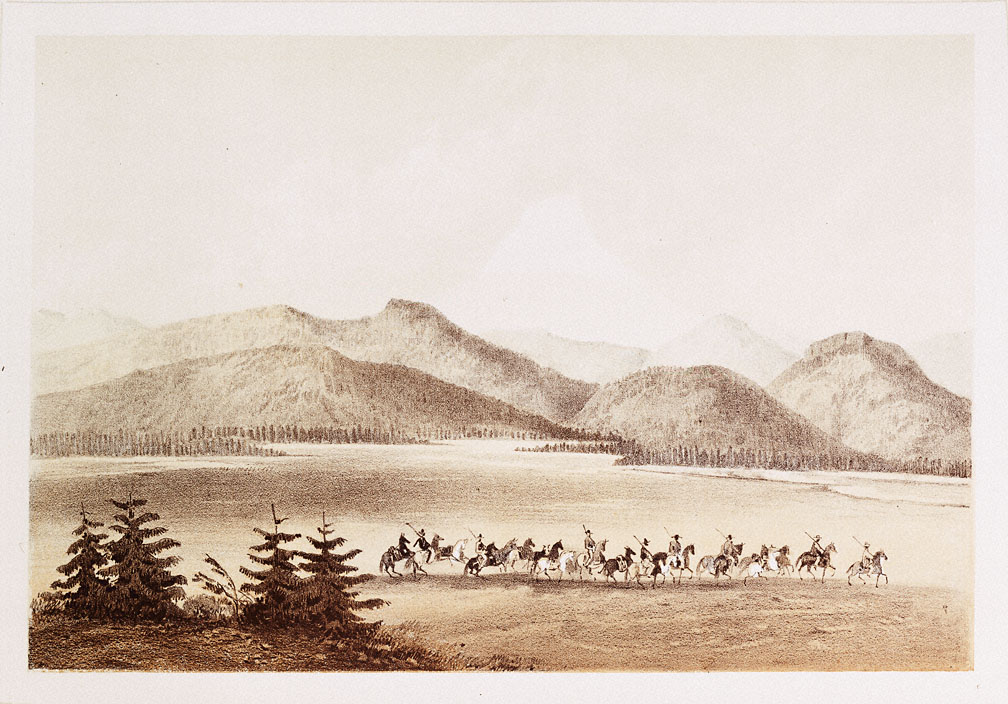- Catalog No. —
- OrHi 104903
- Date —
- 1857
- Era —
- 1846-1880 (Treaties, Civil War, and Immigration)
- Themes —
- Environment and Natural Resources, Exploration and Explorers, Native Americans, Transportation and Communication
- Credits —
- Oregon Historical Society
- Regions —
- Cascades Central
- Author —
- Robert S. Young
Mount Hood from Tysch Prairie
This lithograph is based on an original watercolor by Robert S. Young, the artist who accompanied the Pacific Railroad Survey of 1855 commanded by Lieutenants Robert Stockton Williamson and Henry Larcom Abbot.
The Tygh Valley, referred to as “Tysch Prairie” by Henry Abbot, was home to the Tygh people, a western Columbia River Sahaptin group, during the pre-reservation era. In the fall of 1855, the Pacific Railroad Survey expedition commanded by Lieutenant Abbot established a temporary encampment in the Tygh Valley along Tygh Creek. Lieutenant Abbot intended to cross the Cascade Range in the vicinity of Mt. Hood. However, since he was unfamiliar with the region, he required the assistance of the local Native people to reconnoiter a new route.
In early October 1855, Lieutenant Abbot sought the advice of a Mr. Evelyn, the only settler living in the Tygh Valley, in an attempt to enlist the aid of one or more Indian guides for the trip across the Cascades. Mr. Evelyn cautiously advised Abbot to seek the support of Kok-kop, a Tygh headman. At their initial meeting, Kok-kop would not confirm a rumor Abbot had heard about a possible additional route across the mountains. However, the next day, Kok-kop informed Abbot that he had located a young man, Sam An-ax-shat, who could guide the expedition across the Cascades along a route that passed south of Mt. Hood. With the headman’s assistance, Abbot hired An-ax-shat, noting that he was “about eighteen years old, and a very intelligent, neat, as the result proved, trustworthy Indian.” Since An-ax-shat did not speak English, the two communicated using Chinook Jargon, the common language of the Northwest fur trade.
Abbot’s party, which included seventeen men as well as horses and pack mules, departed the Tygh Valley on October 5, 1855. For the next ten days, the group slowly made their way across the Cascades, often following Indian trails that led to various berry harvesting areas in the mountains. Sam An-ax-shat proved a reliable guide, even retrieving a lost pack mule at the end of the trip. The expedition emerged from the foothills of the Cascades near the Clackamas River and encountered their first settler, a Mr. Currin. He informed Abbot that the armed conflict that had erupted between Indians and settlers north of the Columbia had intensified, and settlers in the Willamette Valley were preparing to send a contingent of volunteers to reinforce U.S. Army troops. As a result of the heightened tensions, several Willamette Valley settlers threatened to kill Sam An-ax-shat. He therefore started back across the Cascades alone during the night. He took with him his pay from Lieutenant Abbot, as well as some presents and a supply of provisions for the journey home. In his official report, Abbot wrote: “I have little doubt that we all owe our lives to the fidelity of this Indian.”
Further Reading:
Abbot, Henry L. Report of Lieut. Henry L. Abbot Upon Explorations for a Railroad Route from Sacramento Valley to the Columbia River. Washington, D.C., 1857.
